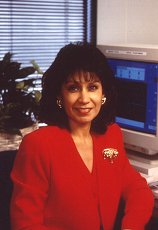





 |
EAC Focus - Ruth Gonzalez |
Ruth Gonzalez is an expert in seismic imaging methods. Working with seismic data collected on the surface of the earth, she develops algorithms that perform calculations to produce images of the underlying geology. Since 1980, she has applied this technology to help discover oil and gas reservoirs for Exxon. "We use sound energy to help us determine exactly what the earth looks like beneath its surface, much like doctors use ultrasounds to take a peek at an unborn child, or x-rays of your body to help in diagnosing medical problems," she explains of the seismic process. "Our wave equations describe how waves propagate through different materials such as rocks, water, and air. This means that mathematics allows us to see several miles into the earth without invasive processes."
According to Gonzalez, a typical 3D seismic dataset contains about 400 gigabytes of data. "We make simplifying assumptions, use massively parallel computers like the Cray T3D with 256 processors, and rely on high-speed disk and tape to compute accurate solutions within a reasonable time frame. These images are used by Exxon geologists and geophysicists to predict the right places to drill." Gonzalez points out that the advances in parallel computing have made these solutions tractable and routine today. "Computing times, even with vector machines, were estimated to be years compared to the weeks that they actually take on parallel machines," she says. "This allows us to explore for hydrocarbons in complex areas that were previously thought to be too risky."
Gonzalez became interested in the application of mathematics to real-world problems as a college student at the University of Texas at Austin. She received her B.A. and M.A. in mathematics in 1975 and 1979 and was a researcher at Applied Research Laboratories at the university from 1976 to 1980. There, she worked on wave propagation problems in underwater acoustics that were of interest to the U.S. Navy. "This was my first encounter with real-life problems using applied mathematics," she says. " I developed mathematical models that allowed other scientists to best position submarines so that they could remain undetected by potential attackers."
Gonzalez joined Exxon Production Research Company (EPR) in 1980 and began working toward her Ph.D. in applied mathematics at Rice University in 1981. She received her degree in 1986. Although her doctoral research focused on the computational mathematics in simulating fluid flow through oil and gas reservoirs, she continued to focus on seismic imaging at Exxon. She worked at another Exxon company, Exxon Exploration, from 1992 to 1996 and is now back at EPR. Throughout her career she has been a consultant and mentor for researchers at various Exxon companies, teaching them how to use seismic imaging technologies.
Gonzalez is currently developing new methods that take into account the irregular distribution of surface seismic data. This will honor both the kinematics and amplitude information of the recorded seismic waves. "Current theories are true for uniform distribution of surface data," she explains, "but we are rarely able to collect such data in the real world."
Gonzalez is a member of the Society of Exploration Geophysicists and has been a member of the CRPC External Advisory Committee since 1995. She was a member of the external advisory committee for the CRPC's Geoscience Parallel Computation Project (GPCP) from 1993 to 1995, focusing on both reservoir simulation and seismic imaging. She is co-author of the paper, "Interdisciplinary Approach to Maximize Benefits of Prestack Depth Migration," which was selected as one of the best five papers for the Rio '95 Conference in Rio de Janeiro, Brazil.
 Other Issues of PCR Other Issues of PCR
|
 Back to PCR Back to PCR
|
CRPC Home Page |